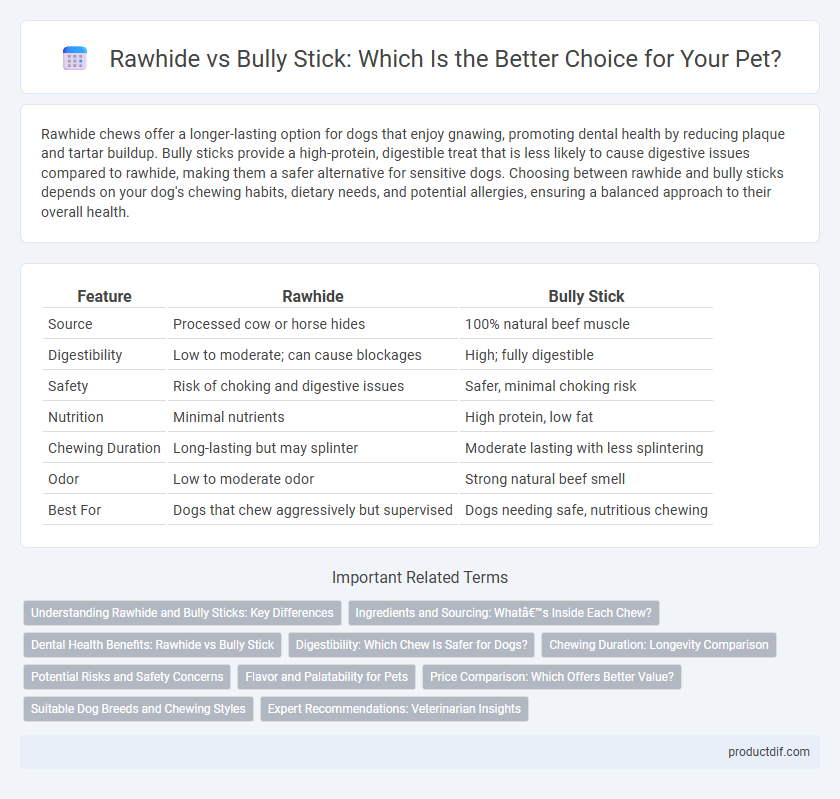Rawhide chews offer a longer-lasting option for dogs that enjoy gnawing, promoting dental health by reducing plaque and tartar buildup. Bully sticks provide a high-protein, digestible treat that is less likely to cause digestive issues compared to rawhide, making them a safer alternative for sensitive dogs. Choosing between rawhide and bully sticks depends on your dog's chewing habits, dietary needs, and potential allergies, ensuring a balanced approach to their overall health.
Table of Comparison
| Feature | Rawhide | Bully Stick |
|---|---|---|
| Source | Processed cow or horse hides | 100% natural beef muscle |
| Digestibility | Low to moderate; can cause blockages | High; fully digestible |
| Safety | Risk of choking and digestive issues | Safer, minimal choking risk |
| Nutrition | Minimal nutrients | High protein, low fat |
| Chewing Duration | Long-lasting but may splinter | Moderate lasting with less splintering |
| Odor | Low to moderate odor | Strong natural beef smell |
| Best For | Dogs that chew aggressively but supervised | Dogs needing safe, nutritious chewing |
Understanding Rawhide and Bully Sticks: Key Differences
Rawhide and bully sticks are popular dog chews with distinct differences in composition and digestion. Rawhide is made from the inner layer of cow or horse hides, often treated with chemicals, which can be harder to digest and sometimes cause digestive blockages. Bully sticks, derived from dried bull or steer pizzle, are fully digestible, high in protein, and generally considered safer and more natural for dogs.
Ingredients and Sourcing: What’s Inside Each Chew?
Rawhide chews are made from the inner layer of cow or horse hides, often treated with chemicals during processing, which may affect ingredient purity. Bully sticks are made from 100% beef muscle, typically sourced from grass-fed, free-range cattle, providing a natural and digestible protein-rich treat. Ingredient transparency and ethical sourcing are key factors in choosing between rawhide and bully sticks for pet safety and nutrition.
Dental Health Benefits: Rawhide vs Bully Stick
Rawhide chews help reduce plaque and tartar buildup by mechanically scraping teeth but may pose choking hazards if ingested in large pieces. Bully sticks, made from natural beef muscle, promote dental health by encouraging chewing that cleans teeth and massages gums while being more digestible and safer than rawhide. Both options support oral hygiene, but bully sticks offer superior safety and nutrient value for maintaining dogs' dental health.
Digestibility: Which Chew Is Safer for Dogs?
Rawhide chews often pose digestibility challenges due to their toughness and potential for causing blockages, making them less safe for dogs prone to digestive issues. Bully sticks are highly digestible, breaking down more easily in the digestive tract and reducing the risk of gastrointestinal complications. Veterinarians frequently recommend bully sticks as a safer alternative because they offer an edible, protein-rich chew that minimizes choking hazards.
Chewing Duration: Longevity Comparison
Bully sticks typically offer longer chewing durations than rawhide due to their dense, fibrous texture that slowly breaks down during chewing. Rawhide tends to soften faster and may be consumed more quickly, reducing overall longevity. Pet owners seeking extended chewing sessions often prefer bully sticks for their sustained durability and natural composition.
Potential Risks and Safety Concerns
Rawhide chews can pose choking hazards and digestive blockages due to their dense texture and potential for unpredictable breakdown in dogs' stomachs. Bully sticks, made from dried bull pizzle, tend to be more digestible but carry risks of bacterial contamination like salmonella if not properly processed. Pet owners should supervise chewing, select appropriately sized treats, and consult veterinarians to minimize risks and ensure safety.
Flavor and Palatability for Pets
Bully sticks offer a natural, meaty flavor that appeals to dogs with strong chewing preferences, promoting longer engagement compared to rawhide. Rawhide tends to have a milder taste, often enhanced with added flavors to increase palatability, but may not satisfy dogs that favor richer textures. Pet owners seeking highly palatable chew options should consider bully sticks for their robust flavor and digestibility benefits.
Price Comparison: Which Offers Better Value?
Rawhide chews generally come at a lower price point than bully sticks, making them a budget-friendly option for pet owners. However, bully sticks, while more expensive, provide better digestibility and nutritional benefits, potentially offering greater value in the long term. Evaluating cost against quality and safety, bully sticks may justify their higher price through enhanced health benefits for dogs.
Suitable Dog Breeds and Chewing Styles
Rawhide chews are ideal for moderate chewers and small to medium dog breeds such as Beagles, Cocker Spaniels, and Bulldogs, as they are softer and more digestible. Bully sticks suit aggressive chewers and larger breeds like German Shepherds, Labradors, and Dobermans, providing a tougher, longer-lasting chewing experience. Selecting chews based on a dog's chewing strength and breed ensures safety and mental stimulation.
Expert Recommendations: Veterinarian Insights
Veterinarians recommend bully sticks over rawhide due to their higher digestibility and lower risk of causing gastrointestinal blockages in dogs. Rawhide chews often contain chemicals from processing and can lead to choking hazards or intestinal obstructions, prompting experts to suggest safer alternatives like bully sticks. Expert insights emphasize choosing bully sticks sourced from reputable suppliers to ensure quality and minimize health risks.
Rawhide vs Bully Stick Infographic

 productdif.com
productdif.com